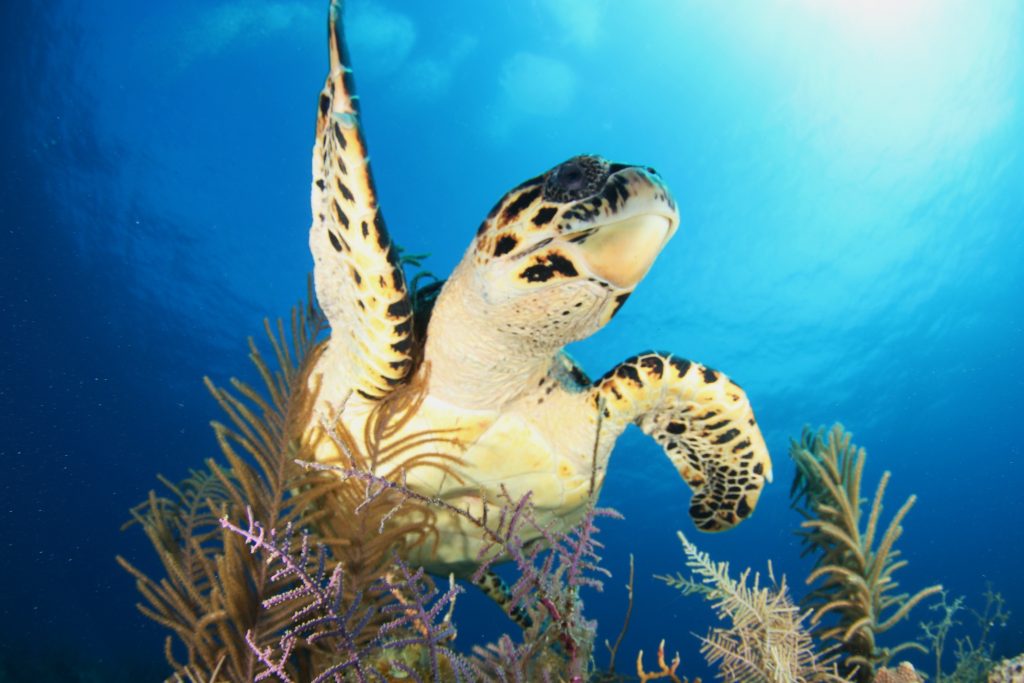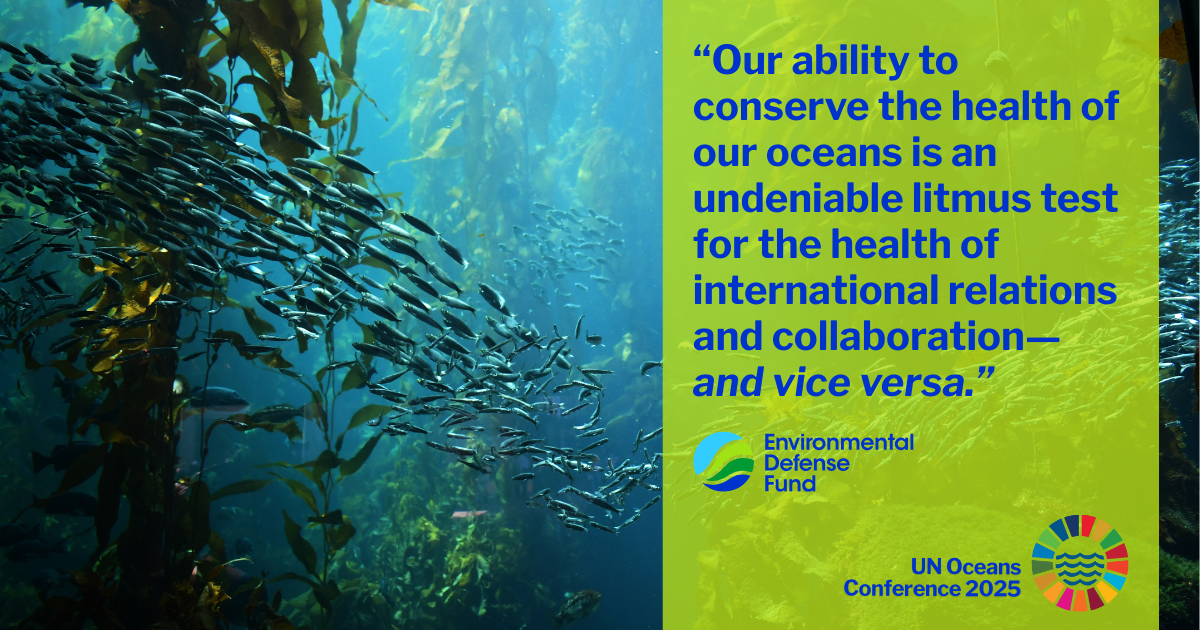Protecting imperiled ocean travelers

By: Katie Westfall & Melissa Mahoney
Across the globe, populations of many highly migratory species of fish, turtles and marine mammals have hit dangerously low levels. For example, Western Pacific leatherbacks have declined more than 80 percent, and their Eastern Pacific counterparts have declined by more than 97 percent. Many of these species play vital roles in maintaining balanced ocean ecosystems full of diversity and life. As we work to reverse these declines, environmentalists have to ensure that everything we do has the greatest positive impact. This means that we’ll need smart management at home and solutions that protect highly migratory species wherever they roam.
New research suggests that well-intentioned U.S. regulations designed to help species like sharks and sea turtles may actually create a net harm to imperiled sea life.
This unintentional negative dynamic can occur when a country, like the United States, unilaterally adopts a regulation to protect an imperiled species such as sea turtles or sharks caught as bycatch. If the regulation leads to decreased fishing domestically and shifts fishing internationally to countries where bycatch rates are higher, the net result can be a higher number of bycatch deaths for the very species the regulation intended to protect. This phenomenon has been called the “transfer effect.”
Taking a closer look at the transfer effect
A group of experts gathered last fall at the University of California, Santa Barbara (UCSB) to explore this phenomenon. Environmental Defense Fund (EDF) and the Bren School of Environmental Science & Management, UCSB convened natural resource economists, biologists, ecologists and fisheries managers during a two-day workshop to discuss research related to the transfer effect, also referred to by other terms such as the “spillover effect” or “leakage.” Participants discussed ways to advance the research and incorporate it into decision-making.
To ensure healthy and abundant populations of these important animals, we must fully understand the real impact of the choices we are making, especially when it comes to species that cross political boundaries and are subject to international agreements. In the United States, we can avoid worsening the overall environmental impact of fishing by crafting domestic regulations that result in avoiding imperiled species and maximizing catch of target species.
Fishermen are crucial to the solution
In order to both reduce bycatch in U.S. fisheries and avoid the negative transfer effect, we need to find solutions that achieve conservation goals while keeping U.S. fishermen on the water. Avoiding heavy-handed conventional management measures that cripple U.S. fishermen, while holding them accountable to bycatch limits and advancing the use of cooperative approaches and science-based bycatch avoidance tools, allows both sustainable and profitable fishing. Electronic monitoring and other technologies will be key to widespread accountability at lower costs. Improved management as opposed to large-scale closures can thus protect both imperiled marine resources and fishing communities.
There are parallels to be drawn from examining approaches to natural resource management from other sectors such as forestry. One researcher estimated that after the implementation of forest conservation policies in a country or a region, a significant portion (42%–95%) of the reduced forestry production can be transferred elsewhere, offsetting environmental gains. If illegal logging—rampant in many tropical timber producing countries, often targeting rare and valuable timber species, and prosecuted with far less care than legal operations— increases as a result of reduced production from better-regulated areas, transfer effects will produce a net harm to forest ecosystems.
With respect to fisheries, one participant summarized this dynamic by asking, “Can the United States have its fish and eat it too?” The reference in their research to the 16th century proverb speaks to whether unilateral regulations in countries with high consumption rates actually achieve their conservation goals. The authors of the paper point to several studies suggesting that U.S. regulations to protect depleted or endangered species like leatherback sea turtles has resulted in increased interactions with the very species intended for protection.
Case studies
In Hawaii, researchers assessed the impacts of a litigation-driven closure of the longline swordfish fishery from 2001 to 2004 to reduce sea turtle bycatch. The fishery reopened later in 2004 with new regulations, including the use of circle hooks, an annual sea turtle bycatch cap and limits on the number of sets fishermen could make. The result was a 90% reduction in the bycatch rate for loggerheads and an 83% reduction for leatherbacks, but also a 50% reduction in Hawaiian swordfish landings. Analyzing this shift, researchers found that if the U.S. fleet had continued to fish at peak levels rather than the gap being filled by other countries, overall we’d have 260 fewer sea turtle interactions per year. Further, they found that if North and Central Pacific countries had the same level of bycatch reduction as the U.S. fleet, we’d have an 83% reduction in sea turtle bycatch (1,878 fewer interactions).
Researchers also assessed the impacts of a large time area-closure encompassing a substantial portion of fishing grounds for the west coast drift gillnet swordfish fleet off the coast of California to protect endangered leatherback sea turtles. They found that the closure transferred effort to other Pacific Rim nation swordfish fleets, which is estimated to have caused the additional bycatch of 1,457 endangered sea turtles compared to 45 turtles had the area remained open.
For species across the coast in the Atlantic Ocean and the Gulf of Mexico, Bren researchers are assessing what would happen if the U.S. pelagic longlining fleet went out of business and transferred quota abroad. Preliminary findings indicate that the transfer of U.S. North Atlantic swordfish quota to the majority of countries receiving swordfish quota from the International Commission for the Conservation of Atlantic Tuna (ICCAT) would result in higher levels of bycatch of species like blue sharks, dusky sharks, blue marlin and loggerhead sea turtles.
Potential confounding variables include other market forces like marketing campaigns, the substitution for and by other products and government influences like subsidies. More research is needed, but overall enough data and analyses exist to give fisheries scientists and managers a more comprehensive perspective when making decisions about how to protect animals like sea turtles and sharks that are inadvertently affected by fishing operations.
Potential solutions
It’s crucial to remember that the food retail industry (i.e. restaurants, grocers, etc.) can play a role in this issue as well. Increasingly, more information is available to major buyers as well as consumers to make informed seafood choices, like EDF’s Seafood Selector and Eat These Fish! campaign to highlight key species in U.S. fisheries that are making a comeback and represent sustainable and delicious choices.
Workshop participants also discussed regulatory efforts to ensure that global fisheries are also operating at high standards. Our nation’s top fishery law, the Magnuson-Stevens Act, along with other existing authorities allow the United States to prohibit imports from countries that do not have equivalent conservation standards for reducing bycatch. Often, imports outcompete U.S.-harvested products and can put U.S. fishermen at a disadvantage. In August, the National Marine Fisheries Services took another important step and issued import provisions of the Marine Mammal Protection Act, which aims to prohibit seafood imports from countries where fisheries kill more marine mammals than U.S. standards allow. Requiring the same standards to access U.S. markets provides strong incentive for countries to reduce bycatch and can help to level the playing field for U.S. fishermen.
Incorporating the transfer effect into decision-making when evaluating alternatives can also help us to evaluate unintended consequences of unilateral policies. In the same way that a National Environmental Policy Act document considers impacts to surrounding local communities, these analyses can also consider whether a transfer effect is likely to result from the policy and whether it will be positive, neutral, or negative for the species requiring the conservation measure. Having global perspective, especially for highly migratory species that transect boundaries, is critical to making every management decision as effective as possible.
Protecting species like sharks and sea turtles requires getting management right at home by implementing the right incentives and flexible, cooperative approaches to ensure that we are not transferring bycatch problems elsewhere. Eating sustainable, U.S.-caught fish promotes fisheries making significant conservation strides. Smart management, together with working with other countries to protect these charismatic ocean voyagers, can reduce or eliminate the transfer effect and help us protect our most loved sea creatures.












